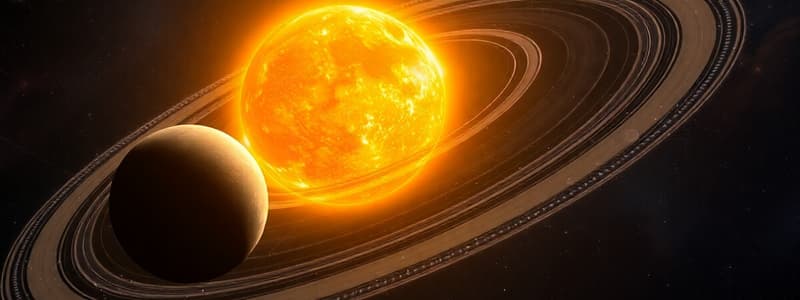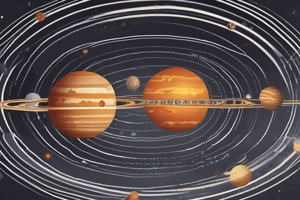Podcast
Questions and Answers
What are the main components of the solar system?
What are the main components of the solar system?
The solar system consists of the Sun, eight planets, dwarf planets, moons, asteroids, and millions of pieces of rocks and ice.
Why do planets stay in orbit around the Sun?
Why do planets stay in orbit around the Sun?
Planets stay in orbit around the Sun due to the gravitational force exerted by the Sun.
What defines a terrestrial planet?
What defines a terrestrial planet?
A terrestrial planet is a smaller planet made mostly of a compact rocky surface and metals.
What are gas giants and how do they differ from terrestrial planets?
What are gas giants and how do they differ from terrestrial planets?
What criteria classify a celestial body as a dwarf planet?
What criteria classify a celestial body as a dwarf planet?
How are asteroids different from meteoroids?
How are asteroids different from meteoroids?
How does gravity affect the rings of Saturn?
How does gravity affect the rings of Saturn?
What is the closest terrestrial planet to the Sun?
What is the closest terrestrial planet to the Sun?
What is the primary location of most asteroids in our solar system?
What is the primary location of most asteroids in our solar system?
What is the Kuiper Belt, and what is its significance?
What is the Kuiper Belt, and what is its significance?
How many moons does Saturn have, and how many of those are confirmed?
How many moons does Saturn have, and how many of those are confirmed?
What role does Earth's moon play in stabilizing the planet?
What role does Earth's moon play in stabilizing the planet?
What distinguishes a galaxy from a solar system?
What distinguishes a galaxy from a solar system?
What is the estimated number of galaxies in the universe according to scientists?
What is the estimated number of galaxies in the universe according to scientists?
How does the gravitational pull of planets affect their moons?
How does the gravitational pull of planets affect their moons?
Define 'scale' in the context of modeling astronomical objects.
Define 'scale' in the context of modeling astronomical objects.
Why is it important to use a scale model to describe the solar system?
Why is it important to use a scale model to describe the solar system?
What defines the only star in our solar system?
What defines the only star in our solar system?
What criteria must an object meet to be classified as a planet?
What criteria must an object meet to be classified as a planet?
Describe the Kuiper Belt.
Describe the Kuiper Belt.
What is the habitable zone around the Sun?
What is the habitable zone around the Sun?
What role does gravity play in our solar system?
What role does gravity play in our solar system?
What characteristics make a planet round?
What characteristics make a planet round?
How does the gravitational force relate to an object's mass?
How does the gravitational force relate to an object's mass?
Flashcards
Asteroid Belt
Asteroid Belt
A region between the orbits of Mars and Jupiter where most asteroids in our solar system reside.
Kuiper Belt
Kuiper Belt
A collection of icy bodies and dwarf planets located beyond the orbit of Neptune.
Moon
Moon
A large natural celestial body that orbits a planet.
Galaxy
Galaxy
Signup and view all the flashcards
Scale Model
Scale Model
Signup and view all the flashcards
Near-Earth Asteroids
Near-Earth Asteroids
Signup and view all the flashcards
Gravity
Gravity
Signup and view all the flashcards
Irregular Galaxy
Irregular Galaxy
Signup and view all the flashcards
What is gravity?
What is gravity?
Signup and view all the flashcards
What is the solar system?
What is the solar system?
Signup and view all the flashcards
Name the eight planets in order.
Name the eight planets in order.
Signup and view all the flashcards
What are terrestrial planets?
What are terrestrial planets?
Signup and view all the flashcards
What are gas giants?
What are gas giants?
Signup and view all the flashcards
What is a dwarf planet?
What is a dwarf planet?
Signup and view all the flashcards
What are asteroids?
What are asteroids?
Signup and view all the flashcards
What is the Kuiper Belt?
What is the Kuiper Belt?
Signup and view all the flashcards
Solar System
Solar System
Signup and view all the flashcards
Planet
Planet
Signup and view all the flashcards
Orbit
Orbit
Signup and view all the flashcards
Habitable Zone
Habitable Zone
Signup and view all the flashcards
Habitable Zone Around the Sun
Habitable Zone Around the Sun
Signup and view all the flashcards
Gravity's Role in our Solar System
Gravity's Role in our Solar System
Signup and view all the flashcards
Study Notes
Solar System Overview
- Our solar system includes the Sun, planets, dwarf planets, moons, and other objects bound by gravity.
- Eight major planets orbit the Sun
- Planets, moons, asteroids, and other objects are held in orbit by the Sun's immense gravitational pull
Gravity in the Solar System
- Gravity is an attractive force between any two objects with mass.
- The larger the mass of an object, the stronger its gravitational pull.
- The Sun's immense mass keeps all the planets and other objects in orbit.
- Gravity holds moons in orbit around planets and asteroids in orbit around other celestial bodies.
Planets and Their Characteristics
- Four inner, terrestrial planets (closest to the Sun) are smaller and rocky (Mercury, Venus, Earth, Mars).
- Four outer, gas giant planets (further from the Sun) are larger and primarily composed of gas (Jupiter, Saturn, Uranus, Neptune).
- These planets have varying atmospheres, temperatures, and orbital periods.
Dwarf Planets
- Dwarf planets are smaller than planets but large enough to be round due to gravity.
- They have not cleared their orbital neighborhood of other objects.
- Pluto is an example of a dwarf planet (reclassified in 2006).
Asteroids and the Kuiper Belt
- Asteroids are smaller than planets but larger than meteoroids.
- Most asteroids orbit the Sun in a region known as the asteroid belt, located between Mars and Jupiter.
- Kuiper Belt is a region beyond Neptune where icy objects reside, including dwarf planets like Pluto .
Moons
- Moons orbit planets.
- Many planets have moons.
- The Moon is Earth's largest moon, which affects Earth's tides.
- Moons are held in orbit by the gravitational pull of the planet they orbit.
Galaxies
- Galaxies are vast collections of gas, dust, and billions of stars.
- Our solar system is part of the Milky Way galaxy.
- There are billions of galaxies in the universe.
Scale Models
- Scale models are used to represent large objects or systems in smaller sizes.
- Scale models help visualize the distances and sizes of celestial bodies in our solar system.
Studying That Suits You
Use AI to generate personalized quizzes and flashcards to suit your learning preferences.




